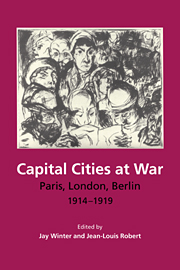Book contents
- Frontmatter
- Contents
- Note on joint authorship
- List of figures
- List of tables
- Part 1 Premises
- Part 2 The Social Relations of Sacrifice
- Part 3 The social relations of labour
- Part 4 The social relations of incomes
- Part 5 The social relations of consumption
- Part 6 Urban demography in wartime
- 14 The ‘other war’ I: protecting public health
- 15 The ‘other war’ II: setbacks in public health
- 16 Surviving the war: life expectation, illness, and mortality rates in Paris, London, and Berlin, 1914-1919
- Part 7 Towards a social history of capital cities at war
- Statistical appendix and tables
- Bibliography
- Index
14 - The ‘other war’ I: protecting public health
Published online by Cambridge University Press: 15 December 2009
- Frontmatter
- Contents
- Note on joint authorship
- List of figures
- List of tables
- Part 1 Premises
- Part 2 The Social Relations of Sacrifice
- Part 3 The social relations of labour
- Part 4 The social relations of incomes
- Part 5 The social relations of consumption
- Part 6 Urban demography in wartime
- 14 The ‘other war’ I: protecting public health
- 15 The ‘other war’ II: setbacks in public health
- 16 Surviving the war: life expectation, illness, and mortality rates in Paris, London, and Berlin, 1914-1919
- Part 7 Towards a social history of capital cities at war
- Statistical appendix and tables
- Bibliography
- Index
Summary
‘The other war’: the phrase comes from the title of George Cahen's book on public health, published in 1920. It refers to the public-health front, the struggle against an invisible enemy capable of sudden and overwhelming attack nullifying the achievements of an entire nation. Images of illness as the enemy within, shadowing everyone at every stage of life, were vivid throughout the war. They expanded vigorously until health care became militarized, not only during but after the war. A Paris obstetrician told midwives in 1922: ‘You are the vanguard of the army waging war on the monstrous plagues – gonococcal infection, syphilis, tuberculosis, even cancer’ Before the Armistice, civil and military authorities were faced with the daunting challenge of waging war on disease at the same time as they waged war on the enemy.
Fear of epidemics and the notion of another front line in the nation's defence were universal. This chapter charts reactions to that peril in the three capital cities. This is a story of both successes, examined here, and failures, described in chapter 15.
As we noted in chapter 11, the pre-war system of social assistance in France was less developed than in Britain or Germany. This was also the case with respect to public-health care. Given the city's history of epidemic disease in wartime, Parisians had cause for anxiety about what the war would bring and what help there would be in the event of an outbreak of contagious disease.
- Type
- Chapter
- Information
- Capital Cities at WarParis, London, Berlin 1914–1919, pp. 421 - 455Publisher: Cambridge University PressPrint publication year: 1997
- 3
- Cited by

